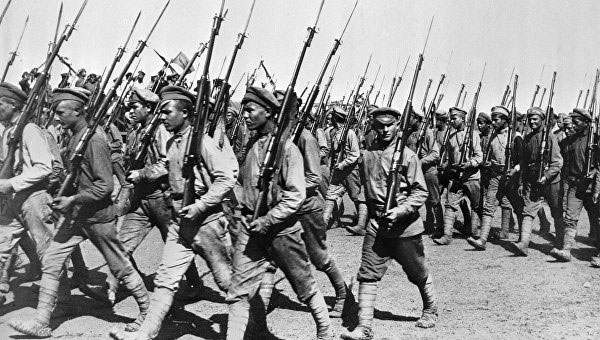The Russian Civil War

General Overview: Following the overthrow of the monarchy in the February Revolution, and the creation of a new type of government following the October Revolution, both Russian reactionaries and the imperialist nations stepped up their attempts to turn back the clock and restore the prerogatives of the old aristocracy.
Russian monarchist military officers mobilized troops still loyal to them -the White Army- to overthrow the Bolsheviks and the Soviet government. In Central and Western Siberia a directory was established by the Whites. In Omsk, former tsarist Admiral Kolchak established an autocratic military dictatorship, while slightly to the west of Vladivostok, in the area of Ulan Ude, the Japanese military enlisted the brutal Ataman Semenov to rule as dictator. The White armies ravaged the countryside, expelling peasants from the land, violently retaking towns and factories, and carrying out pogroms against the Jewish population.
At the same time, Russia was invaded by expeditionary forces of the the imperialist nations. In July, 1918, Japan landed over 72,000 troops in Vladivostok, and spread them throughout Eastern Siberia, claiming the territory as part of Japan. The United States Army landed soldiers to secure the Trans-Siberian railway. Bessarabia, and all of the Ukraine were the French territory of war, while Britain would suppress and capture the Soviet republics in the Transcaucasus and work its way up the southern peninsula of Russia. In the north, the British fleet, with assistance from the French and American fleets, would take control of the Karellian peninsula and the region of Arkhangel'sk; thus surrounding the Soviet government on all sides.
The war was brutal. Untold numbers of workers, peasants, militants and soldiers were killed or maimed. The life of the Soviet republic hung by a thread on more than one occasion. Millions were forced onto the roads to flee violence and famine. Meanwhile, hampered by war, foreign invasion, and economic blockade, the revolutionary government found itself forced to institute a set of drastic economic policies that came to be known as "War Communism", in order to feed the army and the starving urban population.
In the end, the Soviet republic and the revolution survived, but at great human, economic, and political cost.
CHRONOLOGIES OF THE CIVIL WAR
MAPS
Maps of the Russian Civil War, 1920
Maps of the Russian Civil War, 1921-1923
DESCRIPTION AND ANALYSIS
■ Primary documents
The Russian Revolution and Civil War - They are trying to frighten us with civil war, by V. I. Lenin (Sept. 1917)
Tales of Sublieutenant Ilyin, by F. F. Raskolnikov (1918)
The Crisis in Russia, by Arthur Ransome (1920)
Through the Russian Revolution, by Albert Rhys Williams (1921)
Five Years' Struggle, by Victor Serge (1921)
The Paths of the Russian Revolution, Section III, by Karl Radek (1922)
Year One of the Russian Revolution, by Victor Serge (1930)
■ Secondary analyses
The History of the Civil War in the U.S.S.R., Vol. 1, Vol. 2, by M. Gorky, V. Molotov, K. Voroshilov, S. Kirov, A. Zhdanov, J. Stalin (eds.) (1936)
"Intervention and Civil War", from A Short History of the Russian Revolution from 1905 to the Present Day, by R. Page Arnott (1937)
The Secret War Against Soviet Russia, by Isaac Mints (ed.) (1981)
The Russian Civil War, by Megan Trudell (2000)
The Civil War in Russia, its causes and significance, by Yuri Polyakov (1981)
ON THE MILITARY ASPECT
The Red Army, by Erich Wollenberg (1937)
How the Revolution Armed. Military Writings of Leon Trotsky, Vol. 1: 1918, by Leon Trotsky
How the Revolution Armed. Military Writings of Leon Trotsky, Vol. 2: 1919, by Leon Trotsky
How the Revolution Armed. Military Writings of Leon Trotsky, Vol. 3: 1920, by Leon Trotsky
America's Siberian Adventure (1918-1920), by Maj. Gen. William S. Graves (1933)
Armed Intervention in Russia 1918-1922, by W. P. Coates & Zelda K. Coates (1935)
"The Downfall of the Russian 'Whites'", by R. A., in International Press Correspondence, 22 November 1921, pp. 82-83.
"Defending the Gains of the October Socialist Revolution", chapter 1 of A Safeguard of Peace. Soviet Armed Forces: History, Foundations, Mission, by Mikhail Sibilev (1988)
ON THE FAMINE
"The Causes of the Russian Famine", by Victor Serge, in International Press Correspondence, 25 October 1921, pp. 26-28.
The Reality of the Famine, by Victor Serge (1921)
Face to Face with the Famine, by Victor Serge (1922)
"Soviet Russia's Relief for its Starving", by Willy Munzenberg, in International Press Correspondence, 13 January 1922, pp. 33-34.
"Famine Relief - Economic Relief", by Willy Munzenberg, in International Press Correspondence, 17 January 1922, p. 42.
The Restoration of Agriculture in the Famine Area of Russia, by State Economic Planning Commission of the Council for Labour and Defence of the Russian Socialist Federal Soviet Republic (1922)
ON "WAR COMMUNISM"
Problems of Organization of Labor, the Soviet Government, and Industry, from Terrorism and Communism, by Leon Trotsky (1920)
"War Communism", from Lenin. Vol. 3: Revolution Besieged, by Tony Cliff (1978)
"War Communism", from Soviet Russia: Anatomy of a Social History, by Erich Strauss (1941)
_____________
See also: The Kronstadt Rebellion